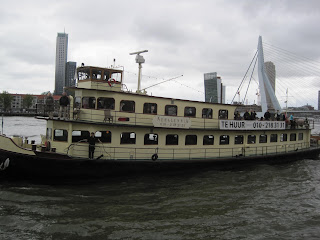This is the last weekend that Marne and Elaine are in the Netherlands, wednesday they're leaving, back to Seattle. I don't want to think to much about it. So this weekend we visited Rotterdam and Kinderdijk. In Rotterdam we visited the Cubic Houses build in the eighties, and in Kinderdijk we visited windmills build in 1740. 
You could say: we go from one extreme to the other.
Rotterdam is one of the biggest harbors in the world, and a mix of traditional and modern architecture. On the 14 mai 1940, the city center of Rotterdam was bombed by the Germans. Around 1 square mile was almost leveled, 24.978 houses, 24 churches, 2.300 stores, 775 warehouses and 62 schools were destroyed. That meant a lot of building after the second world war. 

Around 14.00 we (my parents, M&E, Rob, Paco (our dog) and I ) went on board of the "Nehalennia" to Kinderdijk. It's very nice and quiet way to travel.
What's on the menu today: cycling through the dunes.